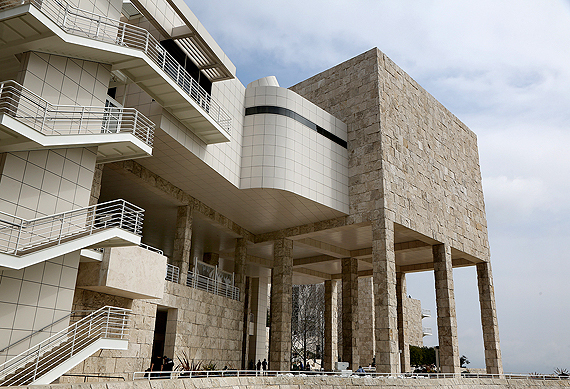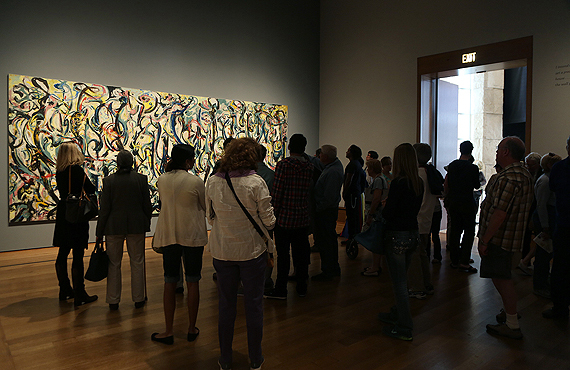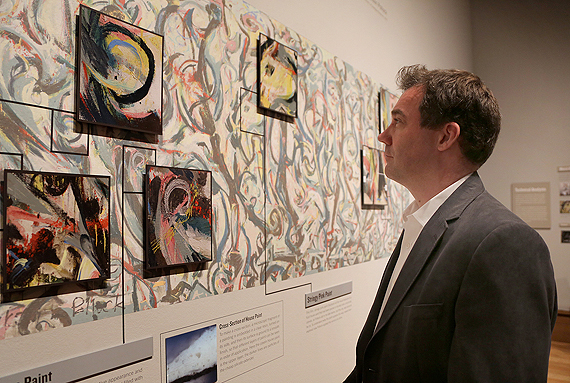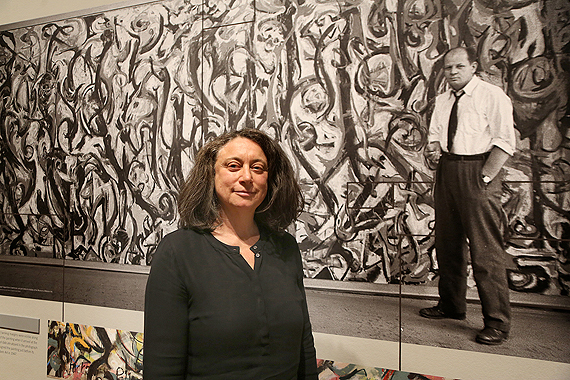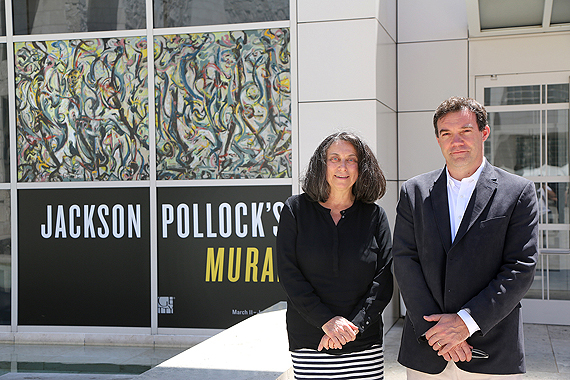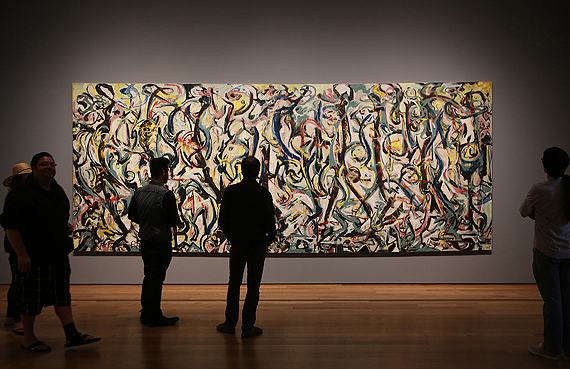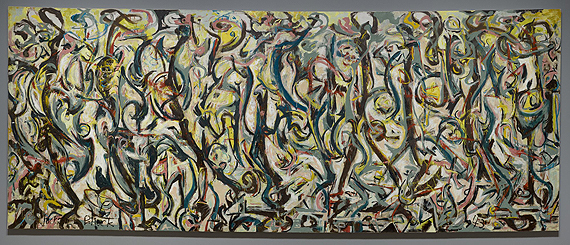
Mural, 1943. Jackson Pollock (American, 1912-1956). Oil and casein on canvas. The University of Iowa Museum of Art, Gift of Peggy Guggenheim. Photo courtesy of the Getty Museum.
On the afternoon of Tues, April 15, 2014 I had the opportunity to meet Melissa Abraham, Getty Communications, to view the latest headlining exhibition at the J. Paul Getty Museum at the Getty Center in Los Angeles.
I was granted an intimate look to photograph Jackson Pollock's monumental painting Mural among the large spring break crowd and take photos of Tom Learner, Head of GCI Science overseeing Mural, 1943. Jackson Pollock. and Yvonne Szafran, Head of the J. Paul Getty Museum's Paintings Conservation department. This rare experience is part of my N(art)rative Series that features photo essays on important moments in Southern California art history.
From the press release: Jackson Pollock's monumental painting Mural and an exploration of its creation, early history and conservation will be on view at the J. Paul Getty Museum at the Getty Center for a limited time March 11 through June 1, 2014.
Following extensive joint study and treatment by the J. Paul Getty Museum and the Getty Conservation Institute (GCI) as part of an agreement with the University of Iowa Museum of Art, the artwork will be exhibited alongside new research, showcasing a significant transitional moment in Pollock's career. The exhibition is jointly curated by Scott Schaefer, Curator Emeritus of the J. Paul Getty Museum; Tom Learner, Head of GCI Science overseeing the GCI's Modern and Contemporary Art Research Initiative; and Yvonne Szafran, Head of the J. Paul Getty Museum's Paintings Conservation department.
Pollock is among the most influential painters in American history, and Mural is widely recognized as a crucial watershed moment for the artist. The storied artwork also has a number of persistent myths associated with it -- the most prevalent being that it was painted by Pollock in a frenzied, 24-hour session. "This painting is of the greatest importance in the history of 20th century art," said Jim Cuno, President and CEO of the J. Paul Getty Trust.
We are honored to have been entrusted with task of scientifically analyzing and treating this painting. Our work has revealed much new and significant information about the painting and its role in a transitional moment in Pollock's career. We are pleased to be able to share this research and the painting itself, which is rarely seen outside of Iowa, with visitors to the Getty from around the world.
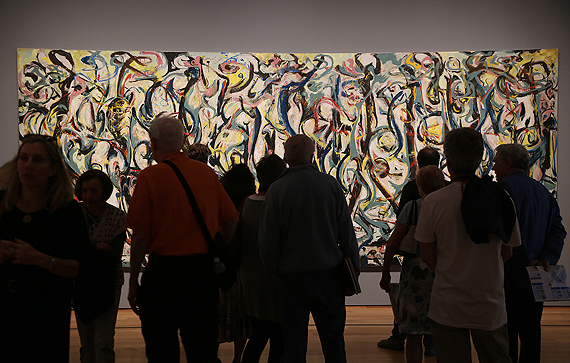
Mural, 1943. Jackson Pollock (American, 1912-1956). Oil and casein on canvas. The University of Iowa Museum of Art, Gift of Peggy Guggenheim. Photo by EMS.
Mural was Pollock's first commission by legendary art collector Peggy Guggenheim and the work has been in the University of Iowa's art collection since it was donated by her in 1951. The painting was likely rolled and unrolled at least five times as it moved from Pollock's studio, to Guggenheim's entrance hall, to Vogue Studios (for photography), to New York's Museum of Modern Art, to Yale University, and finally, in 1951, to the University of Iowa.
This early itinerant history took a toll on its condition. The paint began to flake, and the weak original stretcher caused the painting to develop a pronounced sag. By 1973, its structural condition was in need of attention, and a conservation treatment was carried out in Iowa to stabilize it. This included adhering a lining canvas with wax-resin to the reverse, replacing the original stretcher with a sturdier one, and varnishing the painting.
By 2009, it was evident that further conservation intervention was needed, and experts from the Getty Conservation Institute and the J. Paul Getty Museum were invited to Iowa to assess the condition and display of the painting. While the 1973 treatment had successfully consolidated the paint, it also made the sag a permanent feature, with the adhesive locking the distortion into place. When the painting was re-stretched, the distortion meant that portions of the unpainted tacking margins were now visible on the front of the painting. The varnish applied in 1973 also had dulled the surface.
In July 2012, the painting was transported to the Getty Center for an in-depth study and conservation treatment. Art historical research, conventional methods of treatment and analysis, and some of the latest developments in technical imaging were used to provide new information and insights into the painting and its creation and present Mural in the best possible manner. The analysis and conservation work was jointly undertaken by Learner and Alan Phenix from the GCI, and Szafran and Laura Rivers from the J. Paul Getty Museum.
One exciting discovery has been that Pollock's initial paint marks appear to have been made in four highly diluted colors -- lemon yellow, teal, red, and umber -- all applied wet-on-wet and still visible in several areas of the painting. This presents the intriguing possibility that one of the most prevalent myths -- that Pollock painted the monumental work in one all-night session -- might be partially true.
"It looks as if Pollock did finish some kind of initial composition over much of the canvas very rapidly, perhaps even in a single all-night session. However, the majority of paint layers on Mural were not part of this session, and were frequently added over earlier applications of paint that had already dried, indicating several days or even weeks would have passed between painting sessions," said Learner at the GCI. Further analysis also has provided new information about the paints Pollock used to create his masterpiece. While most of the work was created on Belgian linen canvas with high quality artist's oils, the Getty's investigation yielded another interesting surprise -- simple white housepaint.
The housepaint was used very specifically to regain some pockets of areas of white
space or 'air' after the majority of the work had already been painted.
The Getty team also investigated whether Pollock might have laid the canvas on the floor to drip paint onto the canvas, as he did -- famously -- in later years. "There are several areas of pink paint on Mural where we thought Pollock may have dripped it onto a canvas lying flat on the studio floor. However, we were able to achieve the same results by manipulating an oil paint and flicking it at a test canvas placed upright, so it seems unlikely that he laid this painting horizontally to apply paint to the canvas," said Learner "Having said that, you can certainly glimpse in the application of the splattered paint in Mural how Pollock's style is evolving," added Szafran. "It's a hint of things to come." END PRESS RELEASE
(This article is part of an ongoing photojournalism survey of art exhibition openings in SoCal titled EMS N(art)rative. Through my lens I document a photographic essay or visual "N(art)rative" that captures the happenings, personalities, collectors, gallerists, artists, and the art itself; all elements that form the richly varied and textured fabric of the SoCal art world. This reconnaissance offers a unique view for serious art world players to obtain news and information on the current pulse of what's in the now, yet capturing timeless indelible images for posterity and legacy. Here is EMS N(art)rative Ten.)

